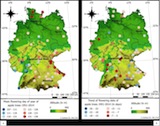l’article du mois – octobre 2019
 Temperature variability between 1951 and 2014 in Germany and associated evolution of apple bloom onset
Temperature variability between 1951 and 2014 in Germany and associated evolution of apple bloom onset
Sarah-Sophie WEIL, Albin ULLMANN, Pierre CAMBERLIN
Climatologie, vol. 15 (2018)
Apple tree bloom onset in Germany has advanced by 2 days/decade in 1951-2014 and by 3 days/decade in 1988-2014, behaving similarly in respect to its evolution since 1951 and its sensitivity to temperature to other species’ phenological spring phases. The evolution however was not linear; by conducting a split moving-window dissimilarity analysis (SMWDA) we were able to detect the “break-period” 1987-1989 which coincides with a breakpoint that has been identified in the phases of the North Atlantic Oscillation (NAO).
We observed distinct spatial patterns with apple bloom advancing from southwest to northeast and, most interestingly, a longitudinal gradient in the trend of apple bloom onset revealed by a probabilistic principal components analysis (PPCA). In the period of 1951-2014, plants located in the east displayed a much stronger trend (-16.53 days on average) than those in the western part of the country (-6.74 days on average). This pattern seems to be linked to patterns in temperature which is highly correlated to apple bloom onset (best one predictor model: mean temperature March to May, R² = 0.82, -6 days/°C): the coldest regions exhibit the strongest warming trends and the greatest advances in apple bloom onset.
Keywords
Phenology, Germany, climate change, apple bloom, breakpoint.
- extrait:
- lien_externe:
- kc_data:
- a:8:{i:0;s:0:"";s:4:"mode";s:0:"";s:3:"css";s:0:"";s:9:"max_width";s:0:"";s:7:"classes";s:0:"";s:9:"thumbnail";s:0:"";s:9:"collapsed";s:0:"";s:9:"optimized";s:0:"";}
- kc_raw_content:
 Temperature variability between 1951 and 2014 in Germany and associated evolution of apple bloom onset
Temperature variability between 1951 and 2014 in Germany and associated evolution of apple bloom onsetSarah-Sophie WEIL, Albin ULLMANN, Pierre CAMBERLIN
Climatologie, vol. 15 (2018)
Apple tree bloom onset in Germany has advanced by 2 days/decade in 1951-2014 and by 3 days/decade in 1988-2014, behaving similarly in respect to its evolution since 1951 and its sensitivity to temperature to other species’ phenological spring phases. The evolution however was not linear; by conducting a split moving-window dissimilarity analysis (SMWDA) we were able to detect the “break-period” 1987-1989 which coincides with a breakpoint that has been identified in the phases of the North Atlantic Oscillation (NAO).
We observed distinct spatial patterns with apple bloom advancing from southwest to northeast and, most interestingly, a longitudinal gradient in the trend of apple bloom onset revealed by a probabilistic principal components analysis (PPCA). In the period of 1951-2014, plants located in the east displayed a much stronger trend (-16.53 days on average) than those in the western part of the country (-6.74 days on average). This pattern seems to be linked to patterns in temperature which is highly correlated to apple bloom onset (best one predictor model: mean temperature March to May, R² = 0.82, -6 days/°C): the coldest regions exhibit the strongest warming trends and the greatest advances in apple bloom onset.Keywords
Phenology, Germany, climate change, apple bloom, breakpoint.
